Medical Imaging: Radiology Technical Supervisor's Role and Challenges
VerifiedAdded on 2022/09/27
|9
|2026
|27
Report
AI Summary
This report addresses the responsibilities and challenges of a radiology technical supervisor in an x-ray department. It outlines the supervisor's vision and mission to provide high-quality, cost-efficient imaging services, emphasizing patient and staff safety and satisfaction. The report details plans for improving patient education, safety, and satisfaction, as well as staff education, safety, and satisfaction. It also discusses strategies to enhance patient flow quality and identifies key challenges within the x-ray department, such as workforce shortages and technological advancements. The report aims to provide a comprehensive overview of the supervisor's role in optimizing the department's performance and patient care.

MEDICAL ASSIGNMENT 1
Medical Assignment
Student’s Name
Institution Affiliate
Date
Medical Assignment
Student’s Name
Institution Affiliate
Date
Paraphrase This Document
Need a fresh take? Get an instant paraphrase of this document with our AI Paraphraser
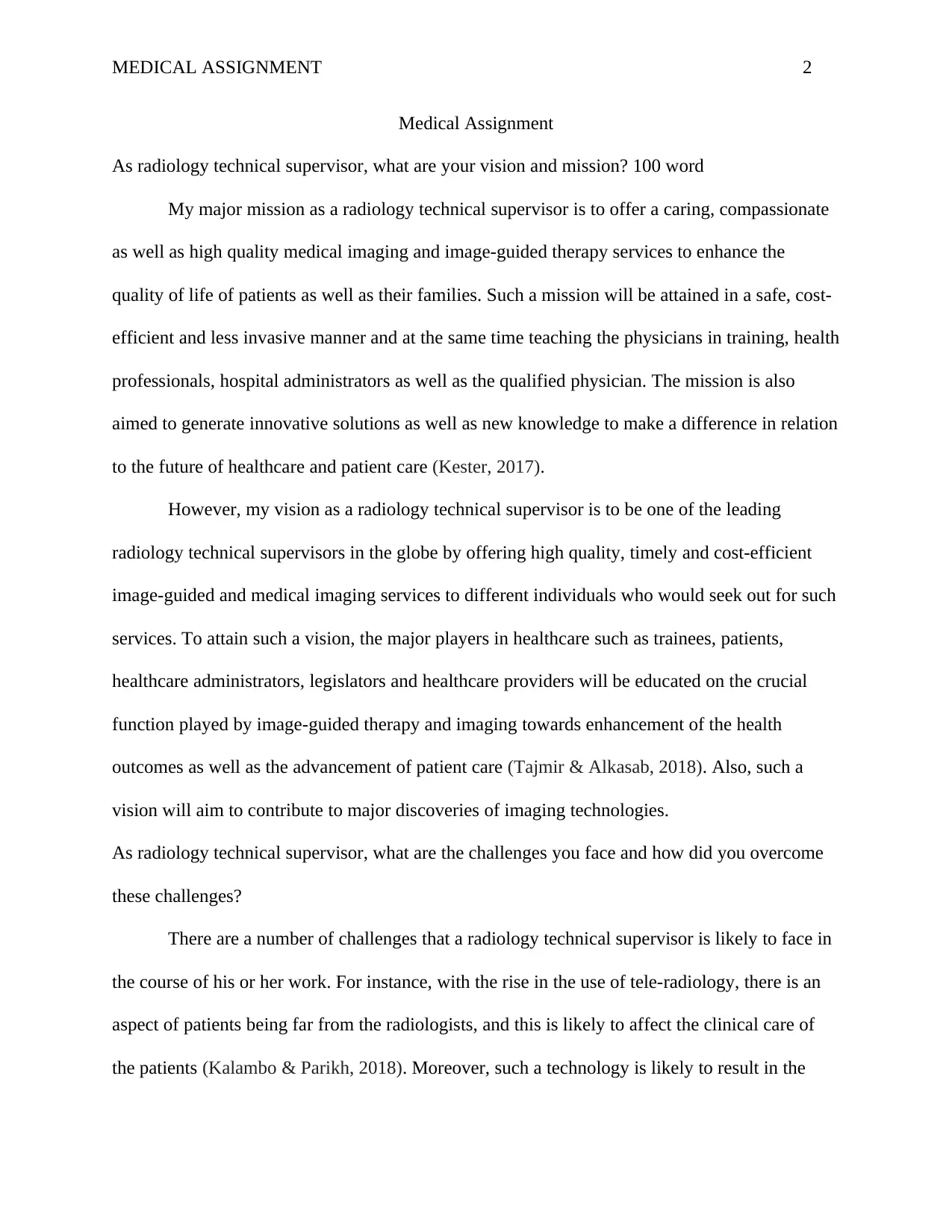
MEDICAL ASSIGNMENT 2
Medical Assignment
As radiology technical supervisor, what are your vision and mission? 100 word
My major mission as a radiology technical supervisor is to offer a caring, compassionate
as well as high quality medical imaging and image-guided therapy services to enhance the
quality of life of patients as well as their families. Such a mission will be attained in a safe, cost-
efficient and less invasive manner and at the same time teaching the physicians in training, health
professionals, hospital administrators as well as the qualified physician. The mission is also
aimed to generate innovative solutions as well as new knowledge to make a difference in relation
to the future of healthcare and patient care (Kester, 2017).
However, my vision as a radiology technical supervisor is to be one of the leading
radiology technical supervisors in the globe by offering high quality, timely and cost-efficient
image-guided and medical imaging services to different individuals who would seek out for such
services. To attain such a vision, the major players in healthcare such as trainees, patients,
healthcare administrators, legislators and healthcare providers will be educated on the crucial
function played by image-guided therapy and imaging towards enhancement of the health
outcomes as well as the advancement of patient care (Tajmir & Alkasab, 2018). Also, such a
vision will aim to contribute to major discoveries of imaging technologies.
As radiology technical supervisor, what are the challenges you face and how did you overcome
these challenges?
There are a number of challenges that a radiology technical supervisor is likely to face in
the course of his or her work. For instance, with the rise in the use of tele-radiology, there is an
aspect of patients being far from the radiologists, and this is likely to affect the clinical care of
the patients (Kalambo & Parikh, 2018). Moreover, such a technology is likely to result in the
Medical Assignment
As radiology technical supervisor, what are your vision and mission? 100 word
My major mission as a radiology technical supervisor is to offer a caring, compassionate
as well as high quality medical imaging and image-guided therapy services to enhance the
quality of life of patients as well as their families. Such a mission will be attained in a safe, cost-
efficient and less invasive manner and at the same time teaching the physicians in training, health
professionals, hospital administrators as well as the qualified physician. The mission is also
aimed to generate innovative solutions as well as new knowledge to make a difference in relation
to the future of healthcare and patient care (Kester, 2017).
However, my vision as a radiology technical supervisor is to be one of the leading
radiology technical supervisors in the globe by offering high quality, timely and cost-efficient
image-guided and medical imaging services to different individuals who would seek out for such
services. To attain such a vision, the major players in healthcare such as trainees, patients,
healthcare administrators, legislators and healthcare providers will be educated on the crucial
function played by image-guided therapy and imaging towards enhancement of the health
outcomes as well as the advancement of patient care (Tajmir & Alkasab, 2018). Also, such a
vision will aim to contribute to major discoveries of imaging technologies.
As radiology technical supervisor, what are the challenges you face and how did you overcome
these challenges?
There are a number of challenges that a radiology technical supervisor is likely to face in
the course of his or her work. For instance, with the rise in the use of tele-radiology, there is an
aspect of patients being far from the radiologists, and this is likely to affect the clinical care of
the patients (Kalambo & Parikh, 2018). Moreover, such a technology is likely to result in the
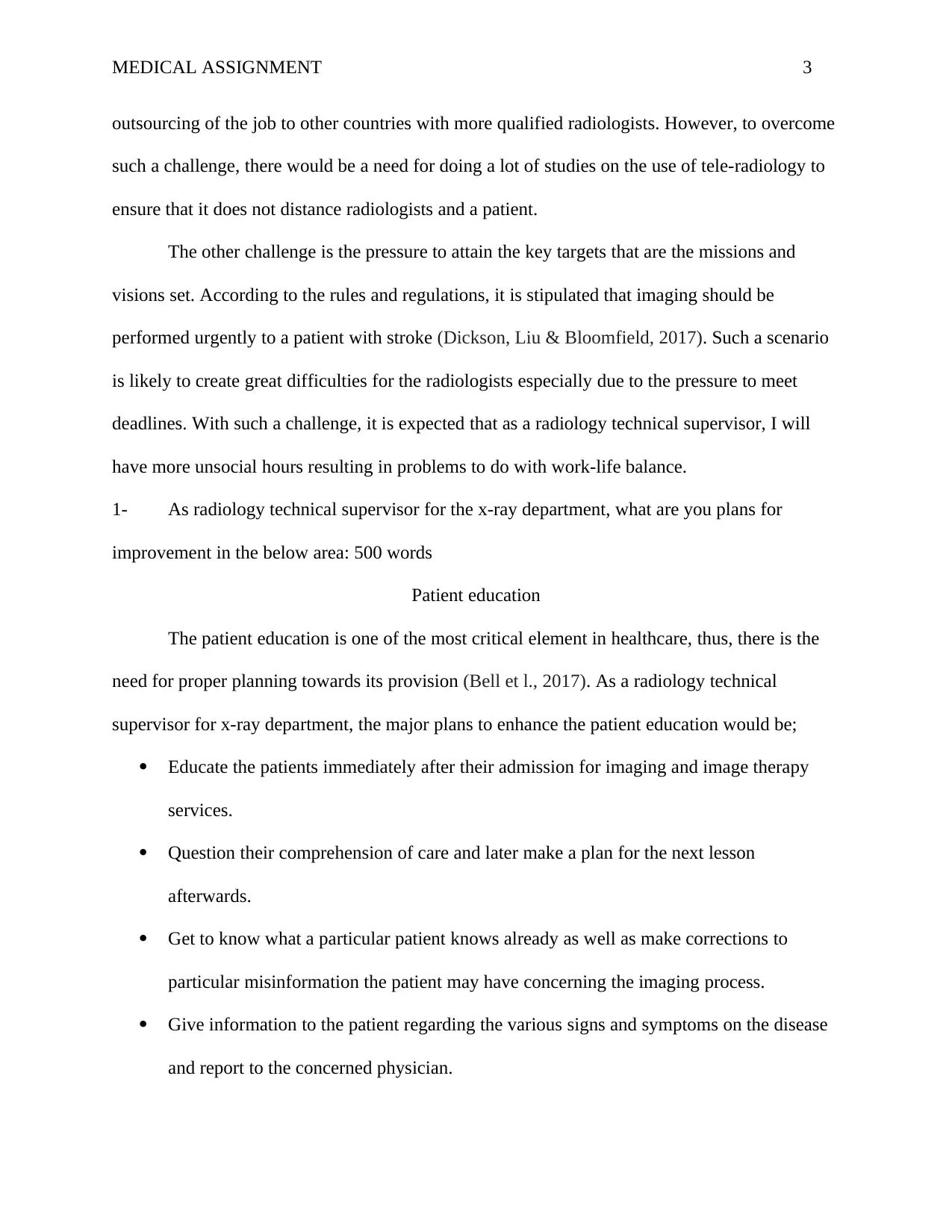
MEDICAL ASSIGNMENT 3
outsourcing of the job to other countries with more qualified radiologists. However, to overcome
such a challenge, there would be a need for doing a lot of studies on the use of tele-radiology to
ensure that it does not distance radiologists and a patient.
The other challenge is the pressure to attain the key targets that are the missions and
visions set. According to the rules and regulations, it is stipulated that imaging should be
performed urgently to a patient with stroke (Dickson, Liu & Bloomfield, 2017). Such a scenario
is likely to create great difficulties for the radiologists especially due to the pressure to meet
deadlines. With such a challenge, it is expected that as a radiology technical supervisor, I will
have more unsocial hours resulting in problems to do with work-life balance.
1- As radiology technical supervisor for the x-ray department, what are you plans for
improvement in the below area: 500 words
Patient education
The patient education is one of the most critical element in healthcare, thus, there is the
need for proper planning towards its provision (Bell et l., 2017). As a radiology technical
supervisor for x-ray department, the major plans to enhance the patient education would be;
Educate the patients immediately after their admission for imaging and image therapy
services.
Question their comprehension of care and later make a plan for the next lesson
afterwards.
Get to know what a particular patient knows already as well as make corrections to
particular misinformation the patient may have concerning the imaging process.
Give information to the patient regarding the various signs and symptoms on the disease
and report to the concerned physician.
outsourcing of the job to other countries with more qualified radiologists. However, to overcome
such a challenge, there would be a need for doing a lot of studies on the use of tele-radiology to
ensure that it does not distance radiologists and a patient.
The other challenge is the pressure to attain the key targets that are the missions and
visions set. According to the rules and regulations, it is stipulated that imaging should be
performed urgently to a patient with stroke (Dickson, Liu & Bloomfield, 2017). Such a scenario
is likely to create great difficulties for the radiologists especially due to the pressure to meet
deadlines. With such a challenge, it is expected that as a radiology technical supervisor, I will
have more unsocial hours resulting in problems to do with work-life balance.
1- As radiology technical supervisor for the x-ray department, what are you plans for
improvement in the below area: 500 words
Patient education
The patient education is one of the most critical element in healthcare, thus, there is the
need for proper planning towards its provision (Bell et l., 2017). As a radiology technical
supervisor for x-ray department, the major plans to enhance the patient education would be;
Educate the patients immediately after their admission for imaging and image therapy
services.
Question their comprehension of care and later make a plan for the next lesson
afterwards.
Get to know what a particular patient knows already as well as make corrections to
particular misinformation the patient may have concerning the imaging process.
Give information to the patient regarding the various signs and symptoms on the disease
and report to the concerned physician.
⊘ This is a preview!⊘
Do you want full access?
Subscribe today to unlock all pages.

Trusted by 1+ million students worldwide
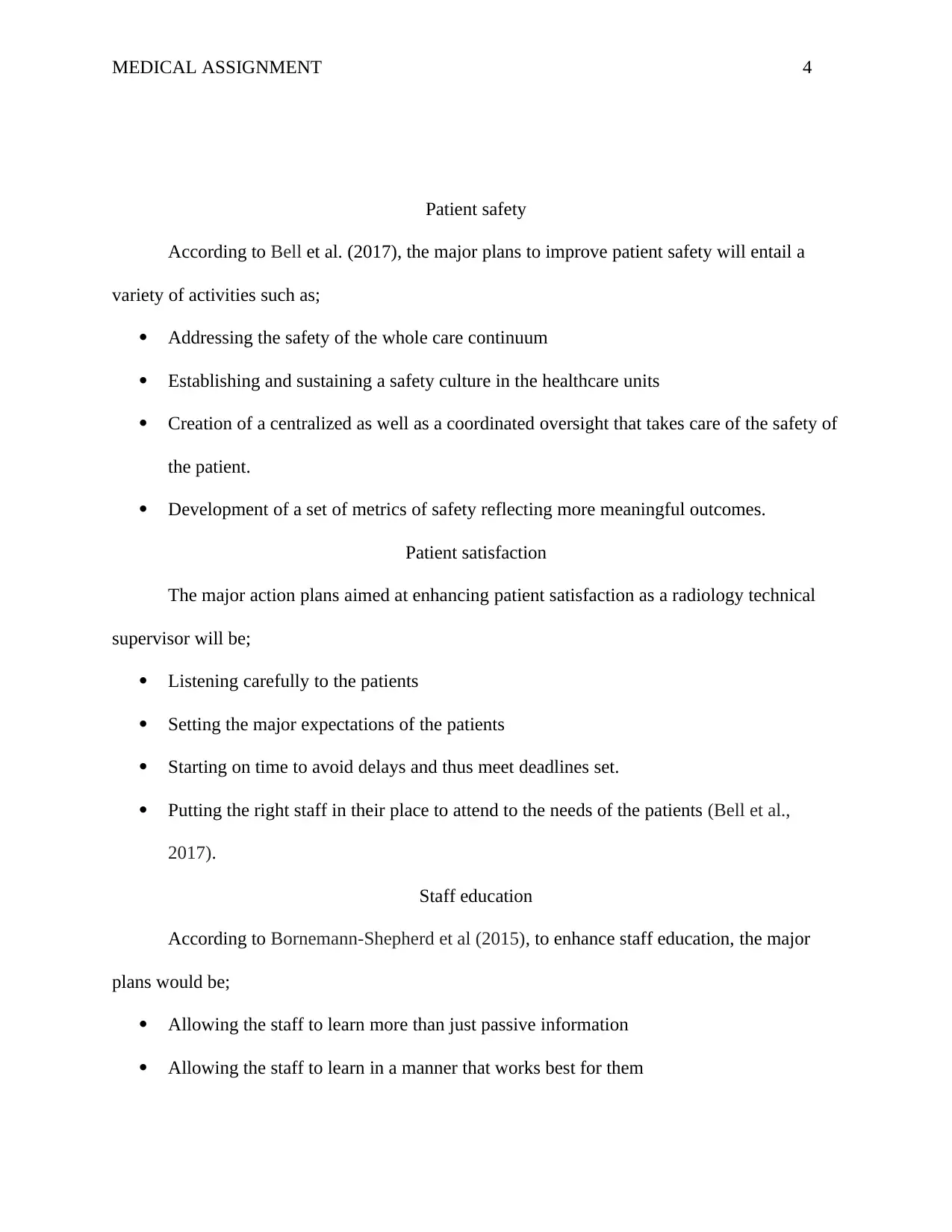
MEDICAL ASSIGNMENT 4
Patient safety
According to Bell et al. (2017), the major plans to improve patient safety will entail a
variety of activities such as;
Addressing the safety of the whole care continuum
Establishing and sustaining a safety culture in the healthcare units
Creation of a centralized as well as a coordinated oversight that takes care of the safety of
the patient.
Development of a set of metrics of safety reflecting more meaningful outcomes.
Patient satisfaction
The major action plans aimed at enhancing patient satisfaction as a radiology technical
supervisor will be;
Listening carefully to the patients
Setting the major expectations of the patients
Starting on time to avoid delays and thus meet deadlines set.
Putting the right staff in their place to attend to the needs of the patients (Bell et al.,
2017).
Staff education
According to Bornemann-Shepherd et al (2015), to enhance staff education, the major
plans would be;
Allowing the staff to learn more than just passive information
Allowing the staff to learn in a manner that works best for them
Patient safety
According to Bell et al. (2017), the major plans to improve patient safety will entail a
variety of activities such as;
Addressing the safety of the whole care continuum
Establishing and sustaining a safety culture in the healthcare units
Creation of a centralized as well as a coordinated oversight that takes care of the safety of
the patient.
Development of a set of metrics of safety reflecting more meaningful outcomes.
Patient satisfaction
The major action plans aimed at enhancing patient satisfaction as a radiology technical
supervisor will be;
Listening carefully to the patients
Setting the major expectations of the patients
Starting on time to avoid delays and thus meet deadlines set.
Putting the right staff in their place to attend to the needs of the patients (Bell et al.,
2017).
Staff education
According to Bornemann-Shepherd et al (2015), to enhance staff education, the major
plans would be;
Allowing the staff to learn more than just passive information
Allowing the staff to learn in a manner that works best for them
Paraphrase This Document
Need a fresh take? Get an instant paraphrase of this document with our AI Paraphraser
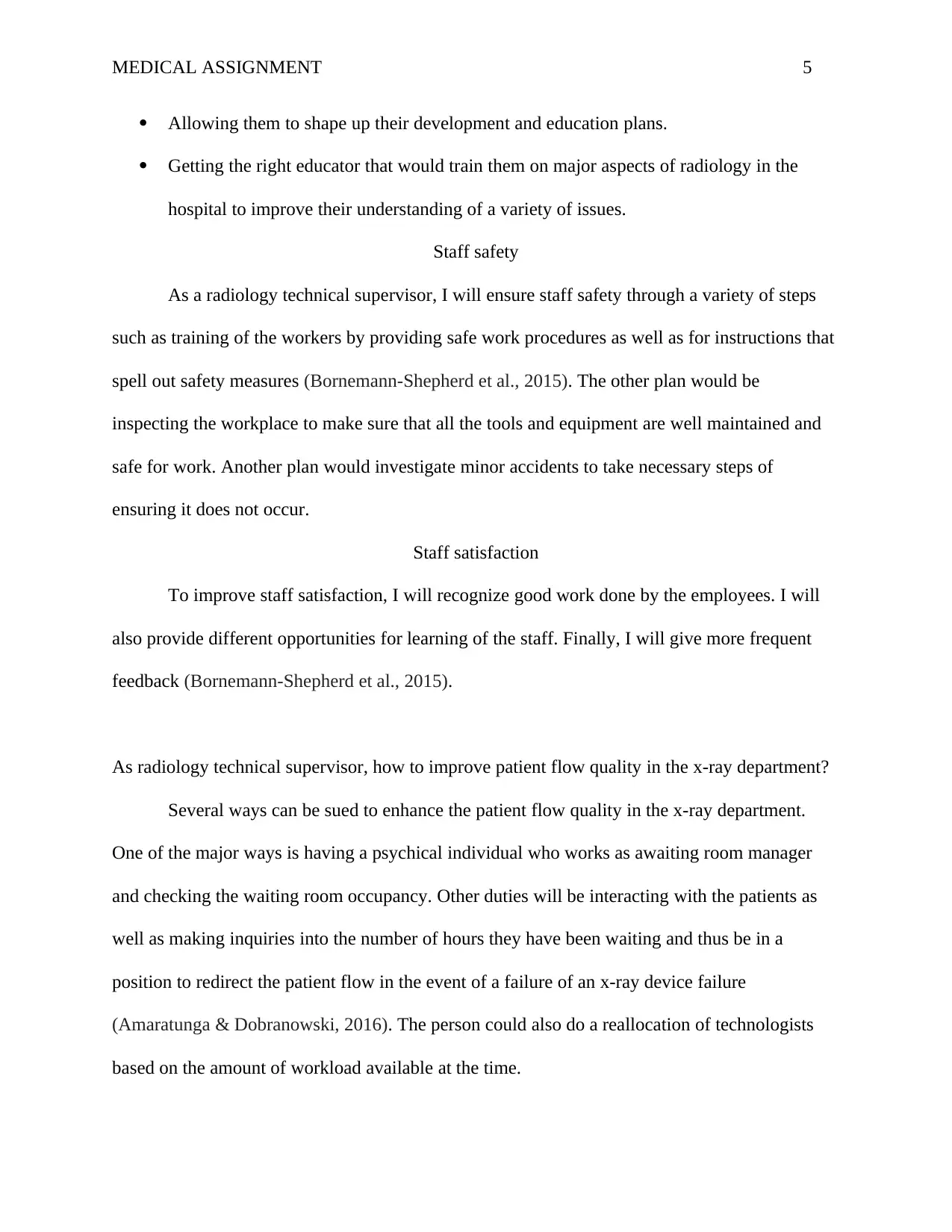
MEDICAL ASSIGNMENT 5
Allowing them to shape up their development and education plans.
Getting the right educator that would train them on major aspects of radiology in the
hospital to improve their understanding of a variety of issues.
Staff safety
As a radiology technical supervisor, I will ensure staff safety through a variety of steps
such as training of the workers by providing safe work procedures as well as for instructions that
spell out safety measures (Bornemann-Shepherd et al., 2015). The other plan would be
inspecting the workplace to make sure that all the tools and equipment are well maintained and
safe for work. Another plan would investigate minor accidents to take necessary steps of
ensuring it does not occur.
Staff satisfaction
To improve staff satisfaction, I will recognize good work done by the employees. I will
also provide different opportunities for learning of the staff. Finally, I will give more frequent
feedback (Bornemann-Shepherd et al., 2015).
As radiology technical supervisor, how to improve patient flow quality in the x-ray department?
Several ways can be sued to enhance the patient flow quality in the x-ray department.
One of the major ways is having a psychical individual who works as awaiting room manager
and checking the waiting room occupancy. Other duties will be interacting with the patients as
well as making inquiries into the number of hours they have been waiting and thus be in a
position to redirect the patient flow in the event of a failure of an x-ray device failure
(Amaratunga & Dobranowski, 2016). The person could also do a reallocation of technologists
based on the amount of workload available at the time.
Allowing them to shape up their development and education plans.
Getting the right educator that would train them on major aspects of radiology in the
hospital to improve their understanding of a variety of issues.
Staff safety
As a radiology technical supervisor, I will ensure staff safety through a variety of steps
such as training of the workers by providing safe work procedures as well as for instructions that
spell out safety measures (Bornemann-Shepherd et al., 2015). The other plan would be
inspecting the workplace to make sure that all the tools and equipment are well maintained and
safe for work. Another plan would investigate minor accidents to take necessary steps of
ensuring it does not occur.
Staff satisfaction
To improve staff satisfaction, I will recognize good work done by the employees. I will
also provide different opportunities for learning of the staff. Finally, I will give more frequent
feedback (Bornemann-Shepherd et al., 2015).
As radiology technical supervisor, how to improve patient flow quality in the x-ray department?
Several ways can be sued to enhance the patient flow quality in the x-ray department.
One of the major ways is having a psychical individual who works as awaiting room manager
and checking the waiting room occupancy. Other duties will be interacting with the patients as
well as making inquiries into the number of hours they have been waiting and thus be in a
position to redirect the patient flow in the event of a failure of an x-ray device failure
(Amaratunga & Dobranowski, 2016). The person could also do a reallocation of technologists
based on the amount of workload available at the time.
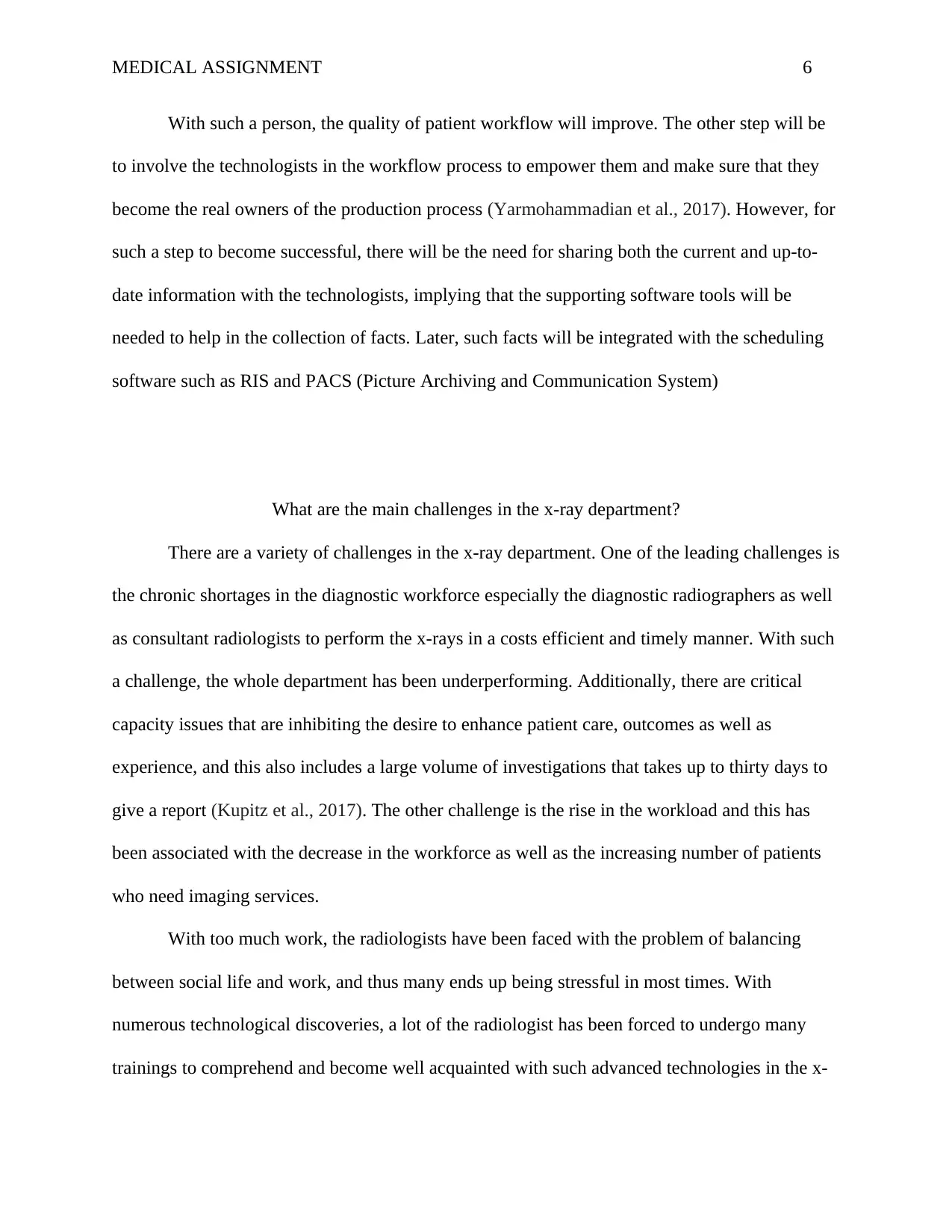
MEDICAL ASSIGNMENT 6
With such a person, the quality of patient workflow will improve. The other step will be
to involve the technologists in the workflow process to empower them and make sure that they
become the real owners of the production process (Yarmohammadian et al., 2017). However, for
such a step to become successful, there will be the need for sharing both the current and up-to-
date information with the technologists, implying that the supporting software tools will be
needed to help in the collection of facts. Later, such facts will be integrated with the scheduling
software such as RIS and PACS (Picture Archiving and Communication System)
What are the main challenges in the x-ray department?
There are a variety of challenges in the x-ray department. One of the leading challenges is
the chronic shortages in the diagnostic workforce especially the diagnostic radiographers as well
as consultant radiologists to perform the x-rays in a costs efficient and timely manner. With such
a challenge, the whole department has been underperforming. Additionally, there are critical
capacity issues that are inhibiting the desire to enhance patient care, outcomes as well as
experience, and this also includes a large volume of investigations that takes up to thirty days to
give a report (Kupitz et al., 2017). The other challenge is the rise in the workload and this has
been associated with the decrease in the workforce as well as the increasing number of patients
who need imaging services.
With too much work, the radiologists have been faced with the problem of balancing
between social life and work, and thus many ends up being stressful in most times. With
numerous technological discoveries, a lot of the radiologist has been forced to undergo many
trainings to comprehend and become well acquainted with such advanced technologies in the x-
With such a person, the quality of patient workflow will improve. The other step will be
to involve the technologists in the workflow process to empower them and make sure that they
become the real owners of the production process (Yarmohammadian et al., 2017). However, for
such a step to become successful, there will be the need for sharing both the current and up-to-
date information with the technologists, implying that the supporting software tools will be
needed to help in the collection of facts. Later, such facts will be integrated with the scheduling
software such as RIS and PACS (Picture Archiving and Communication System)
What are the main challenges in the x-ray department?
There are a variety of challenges in the x-ray department. One of the leading challenges is
the chronic shortages in the diagnostic workforce especially the diagnostic radiographers as well
as consultant radiologists to perform the x-rays in a costs efficient and timely manner. With such
a challenge, the whole department has been underperforming. Additionally, there are critical
capacity issues that are inhibiting the desire to enhance patient care, outcomes as well as
experience, and this also includes a large volume of investigations that takes up to thirty days to
give a report (Kupitz et al., 2017). The other challenge is the rise in the workload and this has
been associated with the decrease in the workforce as well as the increasing number of patients
who need imaging services.
With too much work, the radiologists have been faced with the problem of balancing
between social life and work, and thus many ends up being stressful in most times. With
numerous technological discoveries, a lot of the radiologist has been forced to undergo many
trainings to comprehend and become well acquainted with such advanced technologies in the x-
⊘ This is a preview!⊘
Do you want full access?
Subscribe today to unlock all pages.

Trusted by 1+ million students worldwide

MEDICAL ASSIGNMENT 7
ray department (Zhang et al., 2017). Such is a challenge because it takes time as well as
resources to fully train the radiologists to understand the usage of the new equipment.
ray department (Zhang et al., 2017). Such is a challenge because it takes time as well as
resources to fully train the radiologists to understand the usage of the new equipment.
Paraphrase This Document
Need a fresh take? Get an instant paraphrase of this document with our AI Paraphraser

MEDICAL ASSIGNMENT 8
References
Amaratunga, T., & Dobranowski, J. (2016). Systematic review of the application of lean and six
sigma quality improvement methodologies in radiology. Journal of the American College
of Radiology, 13(9), 1088-1095.
Bell, S. K., Mejilla, R., Anselmo, M., Darer, J. D., Elmore, J. G., Leveille, S., ... & Walker, J.
(2017). When doctors share visit notes with patients: a study of patient and doctor
perceptions of documentation errors, safety opportunities and the patient–doctor
relationship. BMJ Qual Saf, 26(4), 262-270.
Bornemann-Shepherd, M., Le-Lazar, J., Makic, M. B. F., DeVine, D., McDevitt, K., & Paul, M.
(2015). Caring for inpatient boarders in the emergency department: improving safety and
patient and staff satisfaction. Journal of Emergency Nursing, 41(1), 23-29.
Dickson, J., Liu, D., & Bloomfield, D. (2017). Training in clinical oncology and the transition
from trainee to consultant: results of the Royal College of Radiologists' 2015 Post-
Certificate of Completion of Training Survey. Clinical Oncology, 29(3), e64-e71.
Kalambo, M., & Parikh, J. R. (2018). The Community-Based Academic Radiologist. Journal of
the American College of Radiology, 15(10), 1500-1504.
Kester, A. S. (2017). An Analysis of Technical Leadership in Radiology Technology.
Kupitz, C., Olmos Jr, J. L., Holl, M., Tremblay, L., Pande, K., Pandey, S., ... & Tenboer, J.
(2017). Structural enzymology using X-ray free electron lasers. Structural
Dynamics, 4(4), 044003.
Tajmir, S. H., & Alkasab, T. K. (2018). Toward augmented radiologists: changes in radiology
education in the era of machine learning and artificial intelligence. Academic
radiology, 25(6), 747-750.
References
Amaratunga, T., & Dobranowski, J. (2016). Systematic review of the application of lean and six
sigma quality improvement methodologies in radiology. Journal of the American College
of Radiology, 13(9), 1088-1095.
Bell, S. K., Mejilla, R., Anselmo, M., Darer, J. D., Elmore, J. G., Leveille, S., ... & Walker, J.
(2017). When doctors share visit notes with patients: a study of patient and doctor
perceptions of documentation errors, safety opportunities and the patient–doctor
relationship. BMJ Qual Saf, 26(4), 262-270.
Bornemann-Shepherd, M., Le-Lazar, J., Makic, M. B. F., DeVine, D., McDevitt, K., & Paul, M.
(2015). Caring for inpatient boarders in the emergency department: improving safety and
patient and staff satisfaction. Journal of Emergency Nursing, 41(1), 23-29.
Dickson, J., Liu, D., & Bloomfield, D. (2017). Training in clinical oncology and the transition
from trainee to consultant: results of the Royal College of Radiologists' 2015 Post-
Certificate of Completion of Training Survey. Clinical Oncology, 29(3), e64-e71.
Kalambo, M., & Parikh, J. R. (2018). The Community-Based Academic Radiologist. Journal of
the American College of Radiology, 15(10), 1500-1504.
Kester, A. S. (2017). An Analysis of Technical Leadership in Radiology Technology.
Kupitz, C., Olmos Jr, J. L., Holl, M., Tremblay, L., Pande, K., Pandey, S., ... & Tenboer, J.
(2017). Structural enzymology using X-ray free electron lasers. Structural
Dynamics, 4(4), 044003.
Tajmir, S. H., & Alkasab, T. K. (2018). Toward augmented radiologists: changes in radiology
education in the era of machine learning and artificial intelligence. Academic
radiology, 25(6), 747-750.
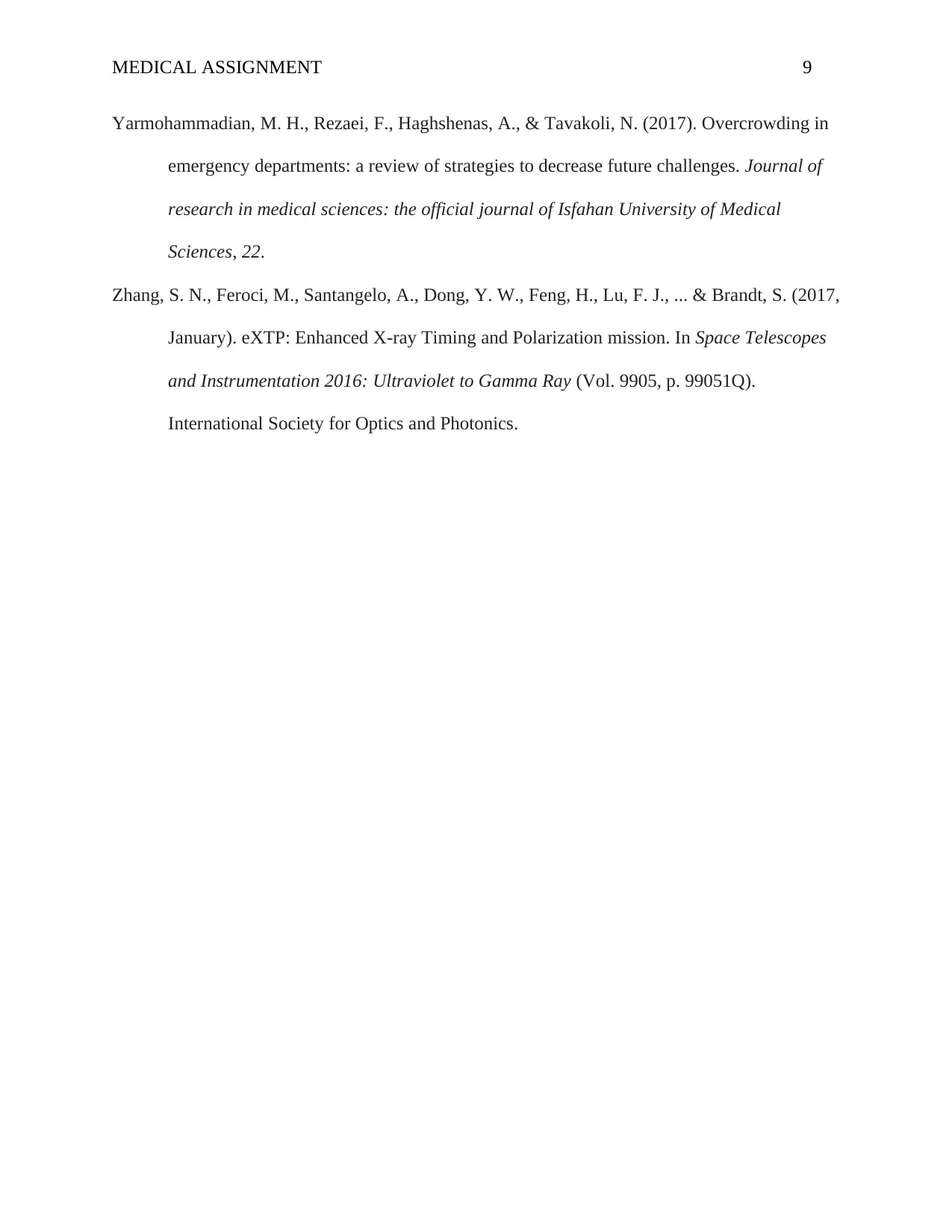
MEDICAL ASSIGNMENT 9
Yarmohammadian, M. H., Rezaei, F., Haghshenas, A., & Tavakoli, N. (2017). Overcrowding in
emergency departments: a review of strategies to decrease future challenges. Journal of
research in medical sciences: the official journal of Isfahan University of Medical
Sciences, 22.
Zhang, S. N., Feroci, M., Santangelo, A., Dong, Y. W., Feng, H., Lu, F. J., ... & Brandt, S. (2017,
January). eXTP: Enhanced X-ray Timing and Polarization mission. In Space Telescopes
and Instrumentation 2016: Ultraviolet to Gamma Ray (Vol. 9905, p. 99051Q).
International Society for Optics and Photonics.
Yarmohammadian, M. H., Rezaei, F., Haghshenas, A., & Tavakoli, N. (2017). Overcrowding in
emergency departments: a review of strategies to decrease future challenges. Journal of
research in medical sciences: the official journal of Isfahan University of Medical
Sciences, 22.
Zhang, S. N., Feroci, M., Santangelo, A., Dong, Y. W., Feng, H., Lu, F. J., ... & Brandt, S. (2017,
January). eXTP: Enhanced X-ray Timing and Polarization mission. In Space Telescopes
and Instrumentation 2016: Ultraviolet to Gamma Ray (Vol. 9905, p. 99051Q).
International Society for Optics and Photonics.
⊘ This is a preview!⊘
Do you want full access?
Subscribe today to unlock all pages.

Trusted by 1+ million students worldwide
1 out of 9
Your All-in-One AI-Powered Toolkit for Academic Success.
+13062052269
info@desklib.com
Available 24*7 on WhatsApp / Email
![[object Object]](/_next/static/media/star-bottom.7253800d.svg)
Unlock your academic potential
Copyright © 2020–2025 A2Z Services. All Rights Reserved. Developed and managed by ZUCOL.


